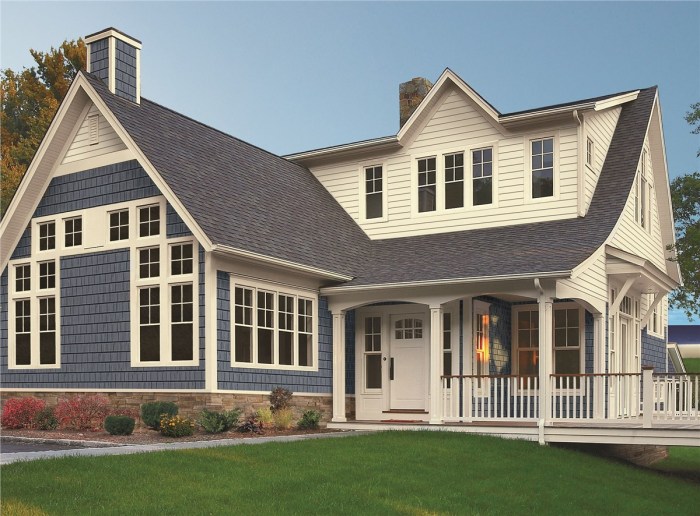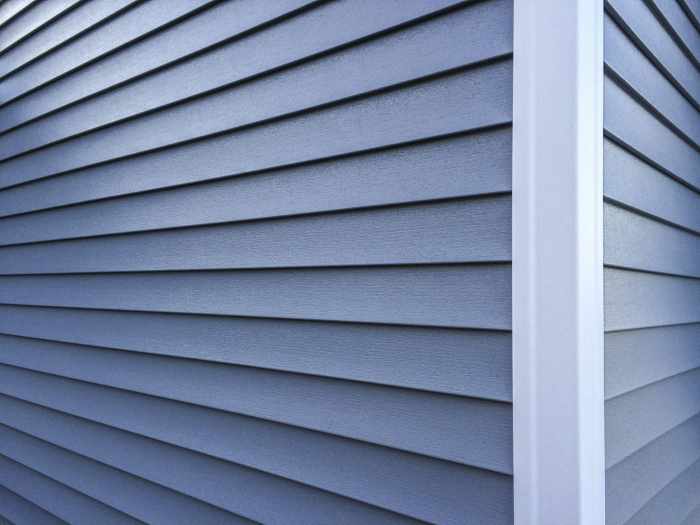Best Siding for Home Insulation? It’s more than just curb appeal; it’s a major player in your home’s energy efficiency. Choosing the right siding can significantly impact your energy bills, comfort levels, and even your home’s resale value. We’ll dive deep into the world of siding materials, exploring their insulating properties, costs, and long-term benefits, helping you make the best decision for your home.
From the thermal resistance (R-value) of different materials like vinyl, fiber cement, wood, and metal, to the impact of color, installation, and even climate, we’ll uncover everything you need to know. We’ll also compare initial costs with potential long-term savings, showing you how a smart siding choice can pay off handsomely. Get ready to transform your home’s energy efficiency—one stylish siding panel at a time!
Siding and Overall Home Energy Efficiency: Best Siding For Home Insulation

Choosing the right siding isn’t just about aesthetics; it’s a crucial element in maximizing your home’s energy efficiency and minimizing your environmental impact. High-performance siding acts as a significant barrier against heat loss in winter and heat gain in summer, directly impacting your heating and cooling costs. This effect is amplified when combined with other energy-saving strategies.Siding’s contribution to overall energy efficiency is most impactful when considered within a holistic home insulation strategy.
It’s not a standalone solution but a vital component working in concert with other upgrades. Think of it as a final layer of protection, sealing in the benefits of improvements made elsewhere.
The Synergistic Effect of Siding with Other Insulation Methods
Effective home insulation is a multi-faceted approach. High-performance siding complements other insulation efforts, creating a synergistic effect that significantly reduces energy consumption. For instance, superior attic insulation minimizes heat transfer through the roof, while properly sealed windows prevent drafts. High-quality siding then acts as an additional layer of protection, preventing heat from escaping through the walls in winter and keeping the interior cool in summer.
Imagine it like this: attic insulation is the roof, window seals are the windows, and siding is the exterior wall, all working together to create a tightly sealed, energy-efficient home. A well-insulated home with high-performance siding will experience a noticeably reduced need for heating and cooling, resulting in substantial energy savings.
Improved Energy Efficiency and Reduced Utility Bills
The financial benefits of choosing energy-efficient siding are undeniable. Studies have shown that homes with properly insulated walls and high-performance siding can experience a reduction in heating and cooling costs of up to 20-30%, depending on climate and existing insulation levels. For example, a homeowner in a colder climate who upgrades to fiber cement siding with enhanced insulation properties might see their annual heating bill decrease by hundreds of dollars.
This translates to substantial long-term savings, quickly offsetting the initial investment in the siding upgrade. The higher upfront cost of energy-efficient siding is quickly recouped through reduced energy consumption.
Environmental Benefits of Energy-Efficient Siding
Beyond the financial advantages, choosing energy-efficient siding contributes to a smaller carbon footprint. By reducing reliance on fossil fuels for heating and cooling, homeowners lessen their contribution to greenhouse gas emissions. This is especially important given the growing global concern about climate change. Furthermore, some siding materials, such as recycled materials or those made from sustainably harvested wood, offer further environmental benefits during the manufacturing process itself.
Choosing these options reduces the overall environmental impact of your home’s construction and maintenance. The long-term environmental impact of such a choice can be considerable, contributing to a more sustainable future.
Maintenance and Lifespan Considerations

Choosing the right siding isn’t just about aesthetics and insulation; it’s also a significant investment that demands careful consideration of long-term maintenance and lifespan. Different siding materials require varying levels of upkeep and boast different lifespans, heavily influenced by environmental factors like sun exposure, moisture, and temperature fluctuations. Understanding these aspects is crucial for making an informed decision that saves you time, money, and potential headaches down the line.The maintenance requirements and lifespans of various siding materials differ considerably.
For instance, vinyl siding generally requires minimal upkeep, while wood siding demands more frequent cleaning and occasional repairs. Similarly, the lifespan of a siding material can vary significantly depending on its quality, installation, and the climate it’s exposed to. A high-quality fiber cement siding installed properly in a mild climate might last for decades, while a low-quality vinyl siding in a harsh coastal environment might need replacing much sooner.
Siding Material Maintenance Comparison
This section compares the maintenance needs of common siding materials. Vinyl siding, known for its low-maintenance nature, typically requires only occasional washing to remove dirt and debris. Wood siding, however, necessitates more frequent cleaning, potentially including staining or sealing every few years to protect against rot and insect damage. Fiber cement siding, a durable option, usually only needs periodic cleaning and occasional spot repairs.
Metal siding, while resistant to many elements, may require repainting or touch-ups over time to maintain its appearance and protect against corrosion. Understanding these differences is key to choosing a siding that aligns with your lifestyle and maintenance capabilities.
Typical Lifespan of Various Siding Types
The lifespan of siding varies greatly depending on the material, climate, and quality of installation. Under ideal conditions, vinyl siding can last 20-40 years, while wood siding, depending on the type of wood and maintenance, might last 20-50 years or even longer. Fiber cement siding often boasts a lifespan of 50 years or more, demonstrating its exceptional durability.
Metal siding, particularly aluminum or steel, can last for 50 years or longer with proper care, making it a long-term investment. However, these lifespans can be significantly shortened by harsh weather conditions, poor installation, or lack of maintenance. For example, a vinyl siding installation in a hurricane-prone area might suffer damage and require earlier replacement than expected.
Maintaining Siding for Optimal Performance and Longevity
Proper maintenance is essential for maximizing the insulation performance and extending the lifespan of any siding material. The following steps provide a general guideline, although specific requirements may vary depending on the material:
- Regular Cleaning: Wash your siding at least once or twice a year to remove dirt, grime, and mildew. Use a gentle cleaner and avoid harsh chemicals that could damage the surface.
- Prompt Repair of Damage: Address any cracks, dents, or loose pieces immediately to prevent further damage and water intrusion. Small repairs can often prevent larger, more costly issues down the line.
- Caulking and Sealing: Regularly inspect and reseal any gaps or cracks around windows, doors, and other openings to prevent water infiltration, which can lead to rot and damage.
- Periodic Inspection: Conduct thorough inspections at least annually to identify potential problems early on. Look for signs of damage, such as cracks, peeling paint, or insect infestation.
- Professional Maintenance: Consider hiring a professional for periodic inspections and repairs, especially for complex issues or materials that require specialized knowledge.
Array
Choosing the right siding isn’t just about insulation; it’s about enhancing your home’s curb appeal and reflecting your personal style. The visual impact of siding significantly contributes to your home’s overall value and aesthetic charm. Consideration should be given to the interplay between siding style, color, and texture, ensuring a cohesive and visually appealing exterior.
Siding Styles and Colors for Various Architectural Styles
The choice of siding should complement your home’s architectural style. A Victorian home, for example, might beautifully showcase the intricate details with clapboard siding in a deep, rich color like a dark brown or deep green, accentuating the ornate trim. The vertical lines of the clapboards add a sense of height and elegance. In contrast, a modern farmhouse might look stunning with sleek, horizontal shiplap siding in a light gray or creamy white, emphasizing the clean lines and minimalist aesthetic.
The smooth, uniform texture of the shiplap contrasts with the rustic charm of the farmhouse style. A Craftsman-style home might benefit from the textured appearance of cedar shake siding, which brings warmth and a natural, rustic feel. A muted earth tone like a warm brown or beige would enhance this aesthetic. Finally, a contemporary home could embrace the smooth, modern look of fiber cement siding in a bold color like charcoal gray or a vibrant blue, making a striking statement.
Impact of Siding Color and Texture on Home Aesthetics
Siding color and texture significantly influence the perceived size, shape, and overall feeling of a home. Lighter colors can make a house appear larger and brighter, while darker colors can create a more intimate and dramatic effect. A smooth texture provides a clean, modern look, while a rougher texture, like that of wood or stone, adds warmth and rustic charm.
For instance, a light-colored home with a smooth, stucco-like texture will project a feeling of spaciousness and modernity. In contrast, a dark-colored home with textured stone siding will appear more substantial and traditional. The interplay of these elements can create a visually stunning and cohesive exterior design. Consider how the colors and textures interact with the surrounding landscape and other elements of the home’s exterior, such as the roof and windows.
Hypothetical House with Two Siding Options, Best Siding for Home Insulation
Imagine a two-story colonial-style house. Option one features classic white vinyl siding with black shutters and trim. This creates a clean, timeless look, emphasizing the home’s traditional architectural details. The light color reflects sunlight, potentially reducing energy costs in warmer climates. Option two uses dark gray fiber cement siding with contrasting white trim.
This provides a more modern, sophisticated aesthetic, creating a strong visual impact. While aesthetically pleasing, the darker color absorbs more heat, potentially increasing cooling costs in warmer climates. The difference in energy efficiency between these two options could be substantial, particularly in regions with significant temperature fluctuations. The lighter-colored vinyl siding would likely offer better energy performance, while the darker fiber cement siding might require more efficient insulation to compensate for increased heat absorption.
Ultimately, selecting the best siding for home insulation involves a careful consideration of various factors. It’s not just about the R-value; the initial cost, long-term maintenance, and aesthetic appeal all play crucial roles. By weighing these elements against your budget, climate, and personal style, you can make an informed decision that boosts your home’s energy efficiency, comfort, and value for years to come.
So, ditch those energy-draining walls and embrace the future of home insulation—it’s stylish, it’s smart, and it saves you money!
Detailed FAQs
What is the lifespan of different siding materials?
Lifespans vary greatly. Vinyl siding can last 20-40 years, fiber cement 50+ years, wood 20-50 years (depending on maintenance), and metal 30-50 years.
Can I install siding myself?
While DIY is possible for some types, professional installation is often recommended for optimal performance and warranty coverage. Improper installation can compromise insulation and longevity.
How often should I clean my siding?
Frequency depends on the material and climate. Generally, annual cleaning is a good practice to prevent dirt buildup and maintain insulation efficiency. Use a soft brush and water; avoid harsh chemicals.
Does siding color affect energy efficiency?
Yes, darker colors absorb more solar heat, increasing cooling costs in warmer climates. Lighter colors reflect more heat, reducing cooling costs. Consider your climate when choosing a color.
Are there any government incentives for energy-efficient siding?
Yes, many local and national governments offer rebates or tax credits for energy-efficient home improvements, including siding. Check with your local energy provider or government websites for details.


